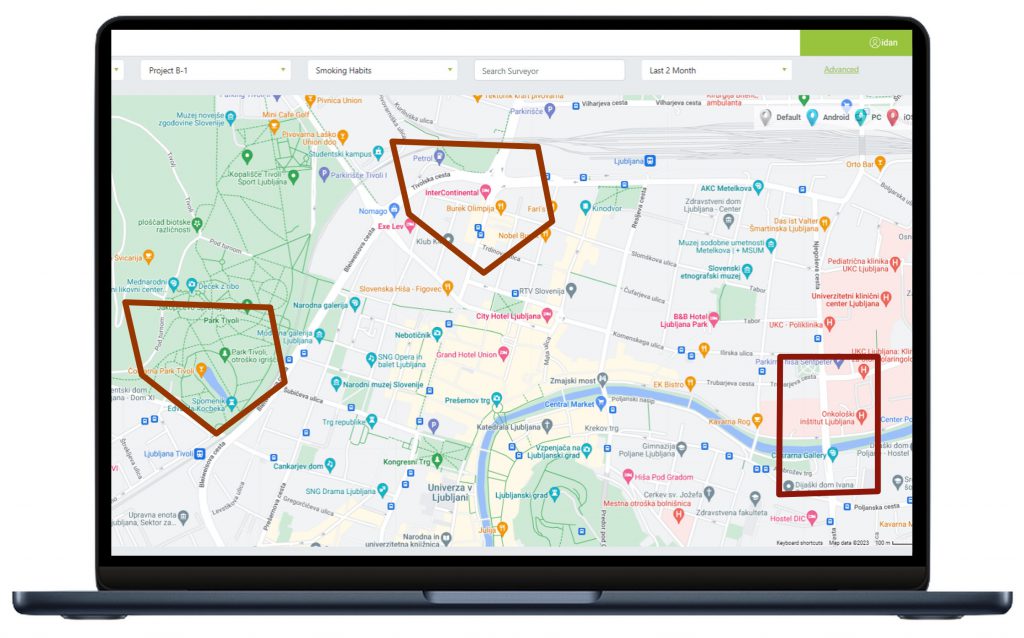Aviv Raizman,
Customer Success Manager at Dooblo
Estimated reading time: 7 minutes
Main topics
- Understand the importance of location accuracy
- Decide how to configure Geo-Fencing in your project
- Learn of the benefits of using Geo-Fencing
Kurtosis Research team is now analyzing its fieldwork finding of a municipal public opinion survey that was planned to be conducted in 10 different neighborhoods.
However, after reviewing some of the data collected in Beta – one of the neighborhoods in the city, it was revealed to the team that the majority of interviews were conducted at Gamma – a neighborhood located 5 miles from Beta. Consequently, much of that data had to be removed, and the fieldwork team had to repeat the fieldwork in Beta. Having the result collected at a different area, this effort joins the length of time that was already dedicated to detect the issue. At this point, the team’s leaders interested to understand how to avoid such situations for future projects, resulting in the time spent on quality checks and the resources invested in the project.
When Location Goes Wrong: Data & Operational Impacts
Location is an essential aspect of any research project for several reasons. Different countries, regions, or even localities have distinct consumer behaviors, preferences, and cultural nuances.
In terms of commercial aspects, climate, terrain, urban or rural environments, and one’s ability to access resources can impact purchasing patterns and product/service requirements.
As the scope of location is quite wide, it would depend on a specific project’s type: a brand awareness test conducted in multiple countries, a specific department in a local supermarket or multi-district survey like the one mentioned at the beginning of this article. Each such location will be considered as PSU: Primary Sampling Unit.
Having to plan a project where PSUs are set in advance also requires a much thorough resource allocation planning: Those are related to location-based sample planning, traveling considerations and costs, number and distribution of surveyors, fieldwork management, quality control and timelines.
Geo-Fencing: Definition and Configuration

In location targeted projects we would normally apply control mechanisms to the data collection platforms in addition to interview volume management, such as quotas and specific interview goals for surveyors. In such projects we would also add location-based control mechanisms with which you capture and control the location of every interview done on a specific project.
Geo Fencing is one of the common techniques to apply on location-based projects and is based on predefining the specific ‘target’ locations (geo-coordinate reference or a defined area), the ability to identify where an interview is conducted and determine the relation (distance, within an area etc.) to the predefined target. Geo Fencing is the commonly used term for the various location validation mechanisms to ensure data is being collected where it was planned to be.
Setting the Geo-fencing mechanism depends much on the characteristics of the planned location, and if it is required to conduct the survey in a proximity specific location or in an area surrounding a specific starting point.
The two options can be defined as:
- Area/Polygon based
- Radius (distance from a center point)
![]()
![]()
![]()
![]()
Setting polygon-based areas is done by a vertical based specific frame in which we need the data from, hence it can be set as specific neighborhoods, stores or any point of interest that has a well-defined containing area. Radius, on the other hand, allows setting a key location with a given distance/length surrounding it. For example, a project that is aimed to measure the possibility of transforming a certain store into a supermarket, where the radius will be set for a total of 1 kilometer from the store. Hence, we will use well defined area in cases where we need to collect data in distinctive PSUs, whereas radius in cases we would like to ensure approximate surroundings around a specific point of interest.
Geo-Fencing Validation During the Interview
Location ‘validity’ can be monitored either at the time of the interview or as part of the Quality Control process stage of the data. In either of the options, the ability to identify a specific location as valid or not can be translated into different operational approaches.
Another aspect that we would need to determine is our location validation methodology. In addition to defining the interviewing target locations (starting point and radius or a well-defined area) we will need to define what actions should be taken on situations where the location is invalid, or when there is no option to identify a location during the interview (device limitations, configuration or location capturing environmental related difficulties). We can decide to notify the surveyor about their wrong or unavailable location information and allow them to correct that, while not allowing them to continue until that is corrected. Another option is to simply indicate that the interview had no location captured, and it will be flagged for additional quality control reviews once the data gets uploaded.
It is important to ensure that the surveyor devices are properly set to enable the location capturing on the SurveyToGo device and data collection application.
Summary
This article covered a common issue faced throughout data collection projects – location deviation, where data has been collected outside of the initially planned location.Having control over your GPS data through built-in Geo-Fencing mechanism allows you to validate the accuracy of your data and save significant resources in and off the fieldwork.
In terms of operation management, determining exact location provides a distinct measure of expenses related to the fieldwork: traveling fees for surveyors, for instance, can be calculated more precisely according to location description of each surveyor. In addition, one will be able to measure the time dedicated to find respondents in each location and compare between productivity metrics on each exact location.
Moreover, setting the survey behavior to disable surveyor from operating the survey outside of defined PSU can save significant amounts of time in QC stages, monitoring each interview location and conducting additional interviews in case a large volume of inaccurate interviews was uploaded.
In conclusion, validating your data’s location is an essential stage to ensure your data quality. When setting a Geo-Fencing structure in your survey, issues related to operation management, as well as the results consisting of the data, are easily controlled in advance and will leverage your operational efficiency.
Learn more on how to set Geo Fencing in your survey in radius or polygons in the attached guides.


